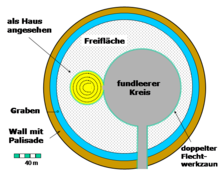Navan Fort
Navan Fort is an archaeological site in County Armagh , Northern Ireland . He is most likely identical with Emain Macha , the capital of the Ulter in the traditional Old and Middle Irish legends of the Ulster cycle . The place where Neolithic , Bronze Age and Iron Age traces were found is said to have been destroyed in AD 332. The legend of the origin of the name Emain Macha is Noínden Ulad ( German "Weakness of the Ulter" )
Archaeological evidence
Two double circles lie within an outer wall and an inner ring trench. The tangent inner circles consisted of double braided walls, between which organic filling material was placed. In the smaller circle measuring approx. 40 m, the traces of five concentric post rings made of 275 oak trunks were seen as roof supports and 34 as edge supports with a diameter of 30 cm. In the center, with a U-shaped post , there was a central pillar . Dendrochronological dating has shown that this post, about 50 cm in diameter and an estimated 12 m height, dates back to 94 BC. Had been felled. The entrance faced west. Immediately after completion, the building was filled with stones, burned down and covered with a 2.5 m thick layer of sod , without the reason for this ritual (?) Being ascertainable. The resulting hill is still 5 m high today and, like the outer wall, remained recognizable. In the larger of the two inner circles of Fort Navan, which are no longer recognizable today, no post marks were found. The fact that Navan Fort is an old cult center or a princely seat with connections to the Mediterranean is confirmed by the discovery of a monkey skull in the archaeological horizon of the 2nd or 3rd century BC. Documented. Brian Boru is said to have visited this place while staying in Armagh , which was the episcopal see of Ireland.
In the post rings of Navan Fort DM Waterman saw the stands of a gigantic round house with a pointed roof and a central post 17-20 m high. Traces of racks found along the wattle wall were referred to by him as beds. In the central position there was a stone trough. Waterman's roof-bearing mast cannot have been placed here.
Nearby, in Loughnashade, there are two lake sacrificial sites, one in the lake directly, the other in a second lake, or better a pond, which was artificially built in the 8th century BC. Was created, with a diameter of 25 m and a depth of 4 m. Human skulls (including the severed facial skull of a young man), animal bones, antlers, swords and bronze trumpets, including a carnyx , which was named Loughnashade trumpet , were recovered from the two sites . These sacrificial sites were the scene of an annual great festival ( Feis Emain Macha ). The artificial pond is now called The King's Stables ("The King's Stables").
On Killylea Road in Armagh, the Navan Center shows the history and legends of this place in the permanent exhibition Rediscover Emain Macha . In 1993 it was recognized as the best tourist exhibition in Northern Ireland.
Emain Macha
Emain Macha [ 'evinʼ' vaxa ] ( German "Macha's twins" ) is the royal seat of Ulster in the stories of Celtic mythology and at the same time an important place of worship. The description of the castle in the Northern Irish sagas largely coincides with the archaeological finds.
In the field name of the area around Navan Fort, Creeveroe , the old Irish name Cræbrúad ("red branch") can be found, this was the name of the festival hall of King Conchobar mac Nessa . The reason for this designation is not known, but the assumed central post of the hall (see above) could mean the “red branch”. However, it is almost certain to assume that the building actually did not serve as a profane festival hall, but as a cult building. The apparently existing actual Königshalle has not yet been found.
In the Ulster cycle, Emain Macha is the setting in the stories Noínden Ulad ("The weakness of the Ulter"), Macgnímrada Con Culainn ("Cú Chulainn's boyhood deeds"), Compert Conchobuir ("Conchobar's conception"), Longas mac nUislenn ("The exile of the sons of Uislius ”), Scéla mucce Meic Dathó (“ The story of Mac Dathó's pig ”) and Táin Bó Cuailnge (“ The cattle robbery of Cooley ”).
In Fled Bricrenn ("Bricrius Fest"), Bricrius Hall is described in detail and it is pointed out that its dimensions and furnishings are similar to conchobars. This huge building is divided into sectors, raised and in the center of the king's, surrounded by those of the twelve most important heroes. The pillars would have been brought in by carts of oxen and seven of the strongest Ulter would have erected them.
See also
literature
- Helmut Birkhan : Celts. Attempt at a complete representation of their culture. Publishing house of the Austrian Academy of Sciences, Vienna 1997, ISBN 3-7001-2609-3 .
- Peter Harbison : Pre-Christian Ireland: From the First Settlers to the Early Celts . Thames and Hudson, London 1988, ISBN 0-500-27809-1 .
- Bernhard Maier : The religion of the Celts. Gods, myths, worldview . Beck, Munich 2001, ISBN 3-406-48234-1 , p. 110 f.
Web links
- Greenwood / Connolly / Wallis: Rough guide to Ireland. Rough Guides, 2003, p. 742.
- Norman / StJoseph: The Early Development Of Irish Society. CUP Archive, p. 75 f.
Individual evidence
- ↑ a b c Helmut Birkhan: Celts. Attempt at a complete representation of their culture. Pp. 770 f, 1016 f.
- ↑ Helmut Birkhan: Celts. Attempt at a complete representation of their culture. Pp. 424, 693, 796.
- ↑ Helmut Birkhan: Celts. Attempt at a complete representation of their culture. Pp. 405, 778.
Coordinates: 54 ° 20 ′ 43 " N , 6 ° 43 ′ 7" W.


